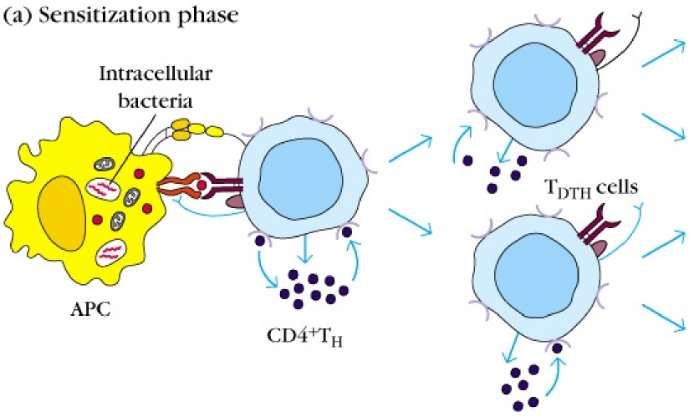Page created on April 19, 2018. Last updated on December 18, 2024 at 16:55

Certain pathogens (all are intracellular bacteria or viruses) and contact antigens cause an immune reaction called hypersensitivity type IV or delayed-type hypersensitivity. Some examples are m. tuberculosis, c. albicans, herpex simplex virus and the measles virus. These pathogens will infect antigen-presenting cells like macrophages or Langerhans cells. The APCs will then degrade some parts of the bacteria and present it on MHC II on the cell surface. A naïve T helper cell will bind to this antigen and differentiate into a TDTH cell, which are mostly the same as TH1 cells. This was the sensitization phase.
If the body cannot remove the antigen, or if there is a re-exposure to it, the effector phase begins. The sensitized TDTH cell will activate and proliferate, and meet other macrophages. When it meets these macrophages, it will activate them. The mechanism of activation is that the TDTH cell secretes IFN-γ and presents TNF-β, both of which will bind to receptors on the macrophage. The TDTH cell will also bind to the MHC II on the macrophage. The combination of these signals will cause the macrophages to grow in size, express more MHC II molecules, express more TNF receptor and produce more reactive oxygen species. The expression of more MHC II and TNF receptor further enhances this immune response. The TDTH cell will then travel to another macrophage and do the same. The ROS and inflammatory cytokines these macrophages produce are what causes the pathological reaction.

When DTH goes horribly wrong
In the case of for example a m. tuberculosis infection, there will be a prolonged DTH reaction, because the m. tuberculosis bacteria is very hard for the body to get rid of. When there has been a prolonged DTH reaction many activated, enlarged and infected macrophages will fuse together into one multinucleated giant cell. This giant cell will be surrounded by activated macrophages and TDTH cells in a clump. This creates something called a granuloma, which causes tissue injury. Granulomas in the lung are typical for tuberculosis.

Contact allergens are something else
Contact allergens also initiate a DTH response.
Typical contact allergens like nickel, hair dye and poison ivy aren’t actually antigens that the body recognizes. They are instead haptens, small molecules that create a complex with other proteins that the immune system can recognize. The proteins in this case are proteins found naturally on or in the skin, which are obviously not recognized by the body as foreign by themselves. However, when a contact allergen binds to these natural proteins, they together become an antigen that Langerhans cells in the skin will recognize and be activated by.
The Langerhans cells will migrate from the skin to lymph nodes, where they will activate T helper cells. These T helper cells will differentiate into TH1 cells, which will travel back to the skin and release typical TH1 cytokines like IL-2 and IFN-γ, which inflame the skin.